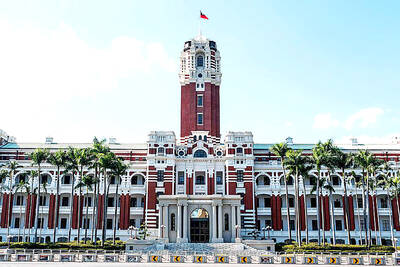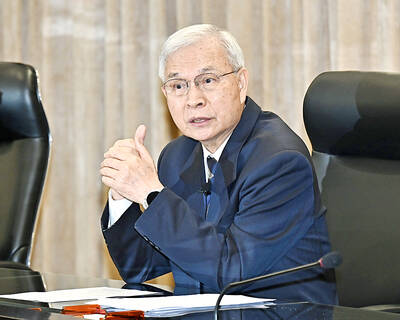Face wrapped in a thick scarf against clouds of blinding dust, the electrician gazed at a maze of pipes and pumps teeming with 15,000 workers and compared his work to building the Tower of Babel.
He was speaking casually. But for the oil industry Kashagan, the world’s biggest discovery since 1968 with reserves locked amid lethal, high-pressure gases beneath the north Caspian Sea, is a challenge of biblical proportions.
“There are people from 30 different countries working here,” said electrician Leonid, asking not to be identified because he was not authorized to speak to the media. “But we do try to find a common language.”

PHOTO: REUTERS
Kashagan, developed by oil majors including Eni and Exxon Mobil, represents all the challenges Western countries face to secure energy supplies as Asia becomes more energy-hungry and Russia seeks to dominate resources on its borders.
The field’s difficult geology, remote location, harsh climate and environmental challenges make it one of the world’s most complex and, at US$136 billion so far, expensive energy projects.
As state-owned companies now control most global reserves, Kashagan shows how Western majors that once dominated the industry now have to take what chances they can to produce oil.
With an estimated 9 billion barrels of recoverable oil, Kashagan is an almighty undertaking.
In temperature swings from minus 40ºC to plus 40ºC, the oil in the Kazakh field is heavy in sulphur — a hazard to health and the environment.
“It’s a project of immense difficulty,” said Eduard Poletayev, an independent analyst who closely watches Kashagan.
Due onstream in three years, Kashagan is one of a dwindling group of giant oilfields as cheaper and more accessible sources dry up. Only 11 such giant fields were found in the 1990s, down from 29 in the 1960s, investment bank Simmons & Co said.
“All the big oilfields have now been gobbled up and Kashagan is the last pearl in the crown of the world oil industry. That’s why oil companies are fighting for it so stubbornly,” Poletayev said.
Expected to produce the equivalent of 10 percent of Europe’s energy needs once at the height of its production, Kashagan can make Kazakhstan a new global source of non-OPEC energy.
It is at the heart of a tussle between Russia, China and Europe, reflecting the challenges faced by the West in maintaining its place as the market of choice for oil producers, and Europe’s battle to reduce its reliance on Russia for energy.
The main question is where the oil will go.
One option is to ship it by tanker across the Caspian Sea to the Baku-Tbilisi-Ceyhan oil pipeline that runs to Europe. BP leads that pipeline, but is not a partner in Kashagan.
Such a route is likely to irritate Russia: Moscow wants to boost its role as Europe’s leading energy supplier by persuading operators to feed the oil into a separate, Russia-bound line run by the Caspian Pipeline Consortium, for transit to Europe.
But the oil could also flow east to energy-hungry China, or — a more controversial possibility — to southern markets via Iran. No single operator holds a deciding majority.
The consortium’s media department in Kazakhstan said it could not comment on possible export routes.
“Kashagan isn’t producing any oil yet so they are being very careful,” Poletayev said. “Because otherwise it’s like selling the bear’s skin before the bear has been caught.”
An hour’s helicopter flight over the emerald green waters of the north Caspian reveals a field of magnificent proportion.
Forming the heart of drilling operations is a scattering of artificial islands encircled by huge man-made reefs designed to prevent shifting ice from destroying drilling rigs in winter.
Onshore, an oil processing facility the size of Washington DC is a swarm of construction activity. In stifling summer heat, that is where Leonid and hundreds of others work.
Once at full capacity, Kashagan will produce 1.5 million barrels of oil per day — enough to power Italy.
Three onshore tanks will contain 2 percent of global daily crude consumption. Electricity will be carried to the field via 6,000km of cable — roughly the distance between London and Kabul.
“This is where the oil will flow from,” said one Kashagan official, who, like most, spoke on condition of anonymity. Where it flows to is “for the politicians to decide.”
Further up the Caspian shore near Kashagan, people in the village of Dossor see no need for anonymity in discussing their experience of oil wealth.
“We have been producing oil for 100 years here,” said Bakhyt Smatullin, an official in charge of local oil production in Dossor, which is home to Kazakhstan’s oldest deposit.
“This village should be made of gold by now,” Smatullin said.
Oil was discovered by Swedish investors 100 years ago, but the village is a ramshackle collection of huts around a few creaking oil rigs. Herds of camels graze nearby.
Up to a quarter of the Kazakh population still lives in poverty despite the oil and metals wealth.
Kashagan became a source of particular tension in 2007 when the Kazakh government accused its operators of allowing costs to spiral and missing the original 2005 production start target.
The row unnerved investors and sparked concerns that the government could embark on a course of resource nationalism, potentially denying the multinationals access.
Adding to its complexity, Kashagan lies at the heart of a delicate ecosystem, home to many species unique only to these waters, such as the rare Caspian seal.
Local campaigners say thousands of dead baby seals have washed ashore since 2000, suggesting the deaths may be linked to oil drilling — a charge denied by Kashagan operators who say they are strongly committed to protecting the environment.
Sulphur is another point of contention. Yellow piles the size of several soccer fields produced elsewhere in Kazakhstan are a common concern.
Ecologists say biodiversity eroded when the Caspian Sea became the subject of mass industrial exploration in Soviet times.
“After the Soviet Union collapsed, all industrial activity stopped and nature became clean,” said Fyodor Sarayev, a local photographer who is documenting disappearing wildlife. “But now the steppe is empty again. The steppe is full of grass but there are no animals to eat it.”

The CIA has a message for Chinese government officials worried about their place in Chinese President Xi Jinping’s (習近平) government: Come work with us. The agency released two Mandarin-language videos on social media on Thursday inviting disgruntled officials to contact the CIA. The recruitment videos posted on YouTube and X racked up more than 5 million views combined in their first day. The outreach comes as CIA Director John Ratcliffe has vowed to boost the agency’s use of intelligence from human sources and its focus on China, which has recently targeted US officials with its own espionage operations. The videos are “aimed at

STEADFAST FRIEND: The bills encourage increased Taiwan-US engagement and address China’s distortion of UN Resolution 2758 to isolate Taiwan internationally The Presidential Office yesterday thanked the US House of Representatives for unanimously passing two Taiwan-related bills highlighting its solid support for Taiwan’s democracy and global participation, and for deepening bilateral relations. One of the bills, the Taiwan Assurance Implementation Act, requires the US Department of State to periodically review its guidelines for engagement with Taiwan, and report to the US Congress on the guidelines and plans to lift self-imposed limitations on US-Taiwan engagement. The other bill is the Taiwan International Solidarity Act, which clarifies that UN Resolution 2758 does not address the issue of the representation of Taiwan or its people in

US Indo-Pacific Commander Admiral Samuel Paparo on Friday expressed concern over the rate at which China is diversifying its military exercises, the Financial Times (FT) reported on Saturday. “The rates of change on the depth and breadth of their exercises is the one non-linear effect that I’ve seen in the last year that wakes me up at night or keeps me up at night,” Paparo was quoted by FT as saying while attending the annual Sedona Forum at the McCain Institute in Arizona. Paparo also expressed concern over the speed with which China was expanding its military. While the US

SHIFT: Taiwan’s better-than-expected first-quarter GDP and signs of weakness in the US have driven global capital back to emerging markets, the central bank head said The central bank yesterday blamed market speculation for the steep rise in the local currency, and urged exporters and financial institutions to stay calm and stop panic sell-offs to avoid hurting their own profitability. The nation’s top monetary policymaker said that it would step in, if necessary, to maintain order and stability in the foreign exchange market. The remarks came as the NT dollar yesterday closed up NT$0.919 to NT$30.145 against the US dollar in Taipei trading, after rising as high as NT$29.59 in intraday trading. The local currency has surged 5.85 percent against the greenback over the past two sessions, central